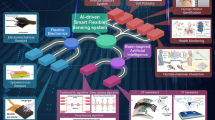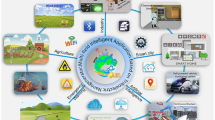Abstract
Our living environments are being gradually occupied with an abundant number of digital objects that have networking and computing capabilities. After these devices are plugged into a network, they initially advertise their presence and capabilities in the form of services so that they can be discovered and, if desired, exploited by the user or other networked devices. With the increasing number of these devices attached to the network, the complexity to configure and control them increases, which may lead to major processing and communication overhead. Hence, the devices are no longer expected to just act as primitive stand-alone appliances that only provide the facilities and services to the user they are designed for, but also offer complex services that emerge from unique combinations of devices. This creates the necessity for these devices to be equipped with some sort of intelligence and self-awareness to enable them to be self-configuring and self-programming. However, with this “smart evolution”, the cognitive load to configure and control such spaces becomes immense. One way to relieve this load is by employing artificial intelligence (AI) techniques to create an intelligent “presence” where the system will be able to recognize the users and autonomously program the environment to be energy efficient and responsive to the user’s needs and behaviours. These AI mechanisms should be embedded in the user’s environments and should operate in a non-intrusive manner. This paper will show how computational intelligence (CI), which is an emerging domain of AI, could be employed and embedded in our living spaces to help such environments to be more energy efficient, intelligent, adaptive and convenient to the users.
Similar content being viewed by others
References
M. Weiser. The Computer for the 21st Century. Scientific American, vol. 265, no. 3, pp. 94–104, 1991.
R. Want, G. Borriello, T. Pering, K. I. Farkas. Disappearing Hardware. IEEE Pervasive Computing, vol. 1, no. 1, pp. 36–47, 2002.
S. Haykin. Neural Networks: A Comprehensive Foundation, Prentice Hall, Upper Saddle River, New Jersey, USA, 1994.
M. Bailey, P. Curtiss. Neural Network Modeling and Control Applications in Building Mechanical Systems. In Proceedings of International Conference of Chartered Institution of Building Services Engineers and American Society of Heating Refrigeration and Air-conditioning Engineers, London, England, 2001, [Online], Avaiable: http://www.cibse.org/pdfs/neural2.pdf, 2001.
S. A. Kalogirou. Artificial Neural Networks in Renewable Energy Systems Applications: A Review. Renewable and Sustainable Energy Reviews, vol. 5, no. 4, pp. 373–401, 2001.
C. W. Anderson, D. C. Hittle, A. D. Katz, P. M. Kretchmar. Synthesis of Reinforcement Learning, Neural Networks, and PI Control Applied to a Simulated Heating Coil. Journal of Artificial Intelligence in Engineering, vol. 11, no. 4, pp. 421–429, 1997.
D. Cohen, M. Krarti. A Neural Network Modeling Approach Applied to Energy Conservation Retrofits. In Proceedings of International Conference on Building Simulation, Madison, Wisconsin, USA, pp. 423–430, 1995.
J. F. Kreider, X. A. Wang. Artificial Neural Network Demonstration for Automated Generation of Energy Use Predictors for Commercial Buildings. ASHRAE Transactions, vol. 91, no. 1, pp. 775–779, 1995.
M. Mozer. Lessons from an Adaptive Home. Smart Environments: Technology, Protocols, and Applications, D. J. Cook, S. K. Das (eds.), John Wiley & Sons, New Jersey, USA, pp. 273–298, 2005.
F. Rivera-Illingworth, V. Callaghan, H. Hagras. Automated Discovery of Human Activites inside Pervasive Living Spaces. In Proceedings of the International Symposium on Pervasive Computing and Applications, Urumchi, Xinjiang, China, pp. 77–82, 2006.
H. Hagras, F. Doctor, V. Callaghan, A. Lopez. An Incremental Adaptive Life Long Learning Approach for Type-2 Fuzzy Embedded Agents in Ambient Intelligent Environments. IEEE Transactions on Fuzzy Systems, vol. 15, no.1, pp. 41–55, 2007.
A. L. Dexter, M. Benouartes. Model Based Fault Diagnosis Using Fuzzy Matching. IEEE Transactions on Systems, Man, and Cybernetics — Part A, vol. 27, no.5, pp. 673–682, 1997.
D. Kolokotsa, G. Stavrakakis, K. Kalaitzakis, D. Tsiavos. Fuzzy Control for Improved Buildings Energy Management Systems. In Proceedings of the European Symposium on Intelligent Techniques, Crete, Greece, 1999, [Online], Available: http://www.erudit.de/erudit/events/esit99/programme.htm, June 3, 1999.
B. Egilegor, P. Uribe, G. Arregi, E. Pradilla, L. Susperregi. A Fuzzy Control Adapted by a Neural Network to Maintain a Dwelling within Thermal Comfort. In Proceedings of Building Simulation, Prague, Czech Republic, vol. 2, pp. 87–94, 1997.
S. Kajl, M. A. Roberge, L. Lamarche, P. Malinowski. Evaluation of Building Energy Consumption Based on Fuzzy Logic and Neural Networks Applications. In Proceedings of CLIMA 2000 Conference, Brussels, Belgium, 1997, [Online], Available: http://www.inive.org/membersarea/medias/pdf/Inive/clima2000/1997/P264.pdf, August, 1997.
U. Rutishauser, J. Joller, R. Douglas. Control and Learning of Ambience by an Intelligent Building. IEEE Transactions on Systems, Man, and Cybernetics — Part A: Systems and Humans, vol. 35, no. 1, pp. 121–132, 2005.
F. Doctor, H. Hagras, V. Callaghan. An Intelligent Fuzzy Agent Approach for Realising Ambient Intelligence in Intelligent Inhabited Environments. IEEE Transactions on Systems, Man, and Cybernetics — Part A: Systems and Humans, vol. 35, no.1, pp.55–65, 2005.
H. N. Lam. Stochastic Modelling and Genetic Algorithm-based Optimal Control of Air Conditioning Systems. In Proceedings of the 3rd International Conference of the International Building Performance Simulation Association, Adelaide, Australia, pp. 435–441, 1993.
H. N. Lam. Intelligent Computer Control of Air Conditioning Systems Based on Genetic Algorithm and Classifier System. In Proceedings of the 4th International Conference of the International Building Performance Simulation Association on Building Simulation, Madison, Wisconsin, USA, pp. 151–157, 1995.
Author information
Authors and Affiliations
Corresponding author
Additional information
Hani Hagras received the B. Sc. and M. Sc. degrees from the Electrical Engineering Department at Alexandria University, Egypt, and the Ph. D. degree in computer science from the University of Essex, UK. He is a professor of computer science, director of the Centre for Computational Intelligence and leader of the Fuzzy Systems Research Group at the University of Essex.
He has authored more than 100 papers in international journals, conferences, and books. He was the principal investigator and co-investigator of many projects. His research has won numerous prestigious international awards where most recently he was awarded by the IEEE Computational Intelligence Society (CIS), the Outstanding Paper Award in IEEE Transactions on Fuzzy Systems. In addition, he was awarded the Institution of Engineering and Technology (IET) Knowledge Networks Award.
He served as the general co-chair of the IEEE International Conference on Fuzzy systems, London, July 2007. He is also the programme chair for the IET International Conference on Intelligent Environments, Seattle, USA in 2008, and the programme chair for the IET International Conference on Intelligent Environments, Ulm, Germany, September 2007. He was also the programme chair for the IET International Conference on Intelligent Environments, Athens, Greece, in 2006, and acted as the co-chair of the organizing committee for the International Symposium on Evolving Fuzzy Systems, 2006. He served as the programme co-chair for the IASTED International Conference on Robotics and Applications, Hawaii, in 2004. He was also the general chair for the IEE International Workshop on Intelligent Environments, Colchester, in 2005. He serves as an associate editor for the International Journal of Robotics and Automation and a guest editor for various special issues in various international journals.
He is a fellow of IET and a senior member of IEEE. He is the chair of the IEEE CIS International Task Force on Intelligent Agents and co-chair of the IEEE CIS International Task Force on Extensions to Type-1 Fuzzy Sets. He is amember of the IEEE CIS Fuzzy Systems Technical Committee. He is also a member of the IEEE Industrial Electronics Society (IES) Technical Committee of the Building Automation, Control and Management. In addition, he is member of the executive committee of the IET Robotics and Mechatronics Technical and Professional Network. He was invited to serve in the International Medical Informatics Association (IMIA) working group on smart homes and ambient assisted living.
His major research interests are in computational intelligence, notably type-2 fuzzy systems, fuzzy logic, neural networks, genetic algorithms, and evolutionary computation. His research interests also include ambient intelligence, pervasive computing, and intelligent buildings. He is also interested in embedded agents, robotics, and intelligent control.
Rights and permissions
About this article
Cite this article
Hagras, H. Employing computational intelligence to generate more intelligent and energy efficient living spaces. Int. J. Autom. Comput. 5, 1–9 (2008). https://doi.org/10.1007/s11633-008-0001-7
Received:
Revised:
Issue Date:
DOI: https://doi.org/10.1007/s11633-008-0001-7




